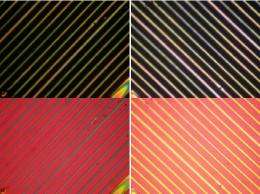Scientists perfect new nanowire technique

Scientists at the University of Leeds have perfected a new technique that allows them to make molecular nanowires out of thin strips of ring-shaped molecules known as discotic liquid crystals (DLCs).
The findings could be an important step in the development of next generation electronic devices, such as light-harvesting cells and low-cost biosensors that could be used to test water quality in developing countries.
DLCs are disk-shaped molecules that are one of the more promising candidates for organic electronic devices. However, controlling their alignment has proved challenging to scientists and this has been a major barrier to their use in the liquid crystal display industry and as molecular wires.
"DLC molecules have a tendency to stack on top of each other like a pile of coins," said researcher Professor Stephen Evans from the University of Leeds. "But the difficulty comes in controlling the orientation of such columnar stacks with respect to the surface on which they lie. This is crucial for their future application.
"Traditionally, scientists have tried to get DLCs to align simply by rubbing the surface they sit on with a cloth to create micro grooves. This fairly primitive method works fine for macroscopic areas, but for new generations of devices we need to accurately control how liquid crystal arranges itself on the surface."
The Leeds team, led by Professor Richard Bushby and Professor Evans, has developed a completely novel technique using patterned surfaces to selectively control alignment, allowing them to stack the piles neatly to create molecular 'wires'.
The technique involves printing sheets of gold or silicon with self-assembled monolayers, which can be patterned with 'stripes' of high and low-energy. When a droplet of liquid crystal is applied to this patterned surface and heated, it spontaneously spreads out like liquid fingers over the high-energy stripes, leaving the low-energy regions bare.
Professor Evans said: "Within the stripes we found molecules arranged into hemi-cylindrical columns each several microns long, which we believe to be the highest level of control over DLC alignment to date. We also found that the narrower the stripes, the better the ordered the columns."
The team are hopeful that this level of control could lead to the development of a new type of biosensor, which could test for anything that alters the surface properties.
"By changing the surface properties we can get switch between alignments which is very interesting from the point of view or sensing devices," added Professor Evans. "Most biosensors require a backlight to see when a change has occurred, but it is very easy to see when a liquid crystal has changed direction – you just hold it up to the light.
"This opens up great possibilities for the production of very simple and, more importantly, cheap biosensors that could be widely used in the developing world."
The team are now testing the conductivity of these wires in the hope that they could be used for energy transfer in molecular systems. They are also looking at ways to polymerise the wires to make them stronger.
More information: The paper, 'Planar Alignment of Columnar Discotic Liquid Crystals by Isotropic Phase Dewetting on Chemically Patterned Surfaces', is available online at onlinelibrary.wiley.com/doi/10 … m.200902140/abstract
Provided by University of Leeds
















